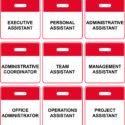
Julia Schmidt shares her strategies and tips for accelerating your onboarding process and finding your feet
Joining a new company is both exciting and challenging. I can remember all the times I have started in a new organization. These moments were always related to going out of my comfort zone, embracing the need to learn, building new relationships, assessing my preferences, creating a new board of advisors, acquiring new skills and engaging with new challenges.
When hired into a new organization Assistants often make lateral moves. We are hired to do things that we have been successful doing elsewhere. However, in many situations, we will be moving to a higher level in the hierarchy. Some of us are moving from a Management Assistant position to an Executive Assistant role. Becoming a C-suite Assistant means becoming part of an executive team, knowing that you must understand what “leadership presence” means in your role.
What really changes?
Imagine you are moving from management level to executive level assistance.
Broader impact horizon
You will be dealing with a wider range of issues, people, and ideas. More than ever, you will need to understand the whole picture of the business.
Greater complexity and ambiguity
You will confront more variables, with a bigger uncertainty about outcome. You are now supposed to delegate more deeply. You will probably be leading a pool of assistants, or having an admin support to book travel, organize events or meetings. With new and more strategic tasks, you must understand the importance of delegating. You will leave behind the operational tasks you had before and embrace more strategic thinking.
Tougher organizational politics
You will be dealing with more powerful stakeholders, groups, and committees, on behalf of your executive. You will be in contact with bank directors, top executives, and more influential people. Decision-making turns out to be more political at a C-suite level. Decisions are made less about authority, and more about influence. It is just unavoidable.
Consequently, you must be more influential and influence in a different way. You must act as a leader by
- Setting the example and aligning actions with shared values
- Inspiring and envisioning a future with exciting possibilities
- Challenging the process and searching for new opportunities and improvements
- Fostering collaboration in your team
- Showing appreciation, celebrating victories and creating a spirit of community
Further from the front lines
As a C-suite Assistant, you will find a greater distance between you and the people “on the front lines”, possibly weakening communication and adding more filters.
It will demand from you a more formal way of communication. Because you will be representing the top leadership, your communication style will have to be aligned with corporate objectives.
More visibility
Much more than before, people will be paying attention to your behavior. You will become an important role model for many employees and teammates.
Consequently, you must keep yourself updated on corporate strategy, decisions, strengths, and weaknesses. You will have to be a visible carrier of the corporate values and be an enthusiastic voice among your colleagues. You must believe in yourself!
Finding your feet in a proactive manner
Now that you have a clear overview of what is changing in your career journey, let’s go through guidelines and actions you must put in practice to show your responsibility for a proactive onboarding process. The guideline is built on four complementary perspectives adapted from Michael D. Watkins’ The First 90 Days.

The culture adaptation
The most frightening challenge for assistants joining new organizations is adapting to unfamiliar cultures. To adapt successfully, you need to understand the patterns people follow for communicating, thinking, making decisions and behaving, all based on people’s shared assumptions and values. The culture in any organization is multidimensional and can be illustrated by the cultural pyramid:

Typically, every organization has a shared language – a list of abbreviations describing business functions, processes, projects, roles, products, and other elements. Language is cultural, and is impacted by the people speaking the language. Some organizations, for example, use the terminology Performance Review, other use Appraisals. The underlying reason to prefer Appraisals cannot be crystal clear to a new employee. We sometimes must analyze the organization’s values, to understand why some words are more representative than others.
Getting ready for the new start before entry
Your learning agenda starts during the job interview. Start by studying the organization’s vision and core values. The company’s website is the first tool for you to navigate the company’s structure before starting. Websites show communication culture, how people are being presented, how people are getting involved in projects, how the products are being advertised. Websites are online brochures that help potential clients, customers, candidates, and partners learn about the company and look at it in a favorable light.
Compare your personal values with the company’s values. Identifying shared values increases enthusiasm and create engagement. Your fundamental values and beliefs represent the core of who you are. What is important for the organization must also be important for you. What you value helps explain what motivates you to choose to join certain organizations and not others.
Talk to your new boss and share ideas during the time you have between signing the contract and the start date. This period – the pre-onboarding phase – can vary from one to three months.
As you begin to learn about the organization, write down your first impressions and eventually some hypotheses.
Compile an initial set of questions to guide your structured inquiry after you arrive.
Time to become a learner again
To understand the new culture, you need to embrace learning from day one. You need to be aware that the way you were always doing things before will not be the best way to do things in the new organization. Getting yourself onboard demands humility and resilience. It is crucial that you invest early on in learning to speak and behave as people in the organization do. Wait until you feel that you are completely adapted, before you start making changes. New employees who start with a high “change agent mindset” can easily get into trouble.
Schedule meetings with each member of the executive team to get an overview of their units. Tell them that you have to understand the whole organization, and they are the best people to help you in the starting phase. Use these meetings to create alliances. Ask open questions and be a good listener. Take notes and start drawing the big picture. You cannot imagine how much you will learn from that experience. It will help you become more influential.
Ask them: What can I do to make the executive team perform better? According to your point of view, what can I do to make our CEO become a better leader?
Get curious. One simple way to exercise initiative is by being curious and asking questions. Questions spark interesting ideas. They build collaborative ideas and activate learning. Print out the relevant documents you need to read – such as company strategy, annual reports, and quarterly business review presentations. While reading the documents, highlight important sentences and words. Make a list of questions and bring them to your one-on-one meetings with your executive. The better the questions, the more rewarding your learning will be.
Try new things. Be prepared to find out new ways to perform your tasks. Learn from new colleagues. To challenge yourself to grow and learn, you have to take the initiative to try new things.
Identifying the Best Sources of Insight
Starting in a new organization calls for proactively restructuring our advice-and-counsel network. Moving into a higher level as an Assistant means needing more political counsel and personal advice. Decision making now is more related to politics and knowing the most influential players in the organizations is crucial.
Experienced Assistants are not only role models, they are also necessary connections to information, resources, and, of course other people. You have to build a more strategic network. It is essential to build a network to compensate for blind spots, those things you do not feel comfortable with. It can, for example, be a good relationship with colleagues in the finance department, if you know you will need special help with finance. We all have weaknesses, so the best way to minimize shortfalls is by getting help from the right people. Therefore, I recommend you to build a network of collaborators as soon as you start in a new organization.
Ask your boss to connect you to key stakeholders. Find a cultural interpreter, someone specialized in the local history and heritage of the company. They can support you in developing tools for interpretation strategies and understanding and respecting cultural diversity. They will translate the organizational culture into a language you understand.
If the company does not have a buddy program, find a buddy, and start a learning plan.
Talk with your predecessor if possible.
Establish a close contact with HR and Sales. My point of view is that an assistant has to be a marketer. You have to know the products, and be an ambassador. Salespeople are always willing to talk about what they sell and do. They are normally the most enthusiastic players in the organization. They are frontline people and have a clear view of challenges and opportunities. They have up-to-date information about trends and imminent changes in the market. Learn from them! HR people are always good carriers of the company’s values. They can teach you the best way to become an ultimate new employee.
Visit the different departments and identify a key person in each of them. Ask those key people to tell you the success stories and relevant accomplishments during the last years.
Visit the company’s plants and offices. Let people tell you what they are proud of.
Connect with people who, based on their experience, can teach you about things you would like to achieve and the skills you would like to acquire. Choose people who make you feel good and inspire you to improve yourself. Look for positive role models.
Create sharing and learning arenas. Your necessity to learn about the organization can be a driver to spread a “learning movement” that will bring benefits to others.
The primary responsibility for accelerating your learning rests on you. However, there are many other players whose support can make the learning process a lot less painful.
Conclusion
You cannot find your feet by relying solely on yourself. You need to delegate, influence, communicate, and show leadership presence. You will be working with a new team. You will be connecting with people, and making many of them part of your network.
When it comes to making connections, you need to make the first move. You need to take the initiative. The connections you are making in the onboarding phase will be important to your future in the organization. As you advance in your career, the quality of your connections becomes more and more significant.
Onboarding is a learning process. Therefore, the most important thing you have when entering a new organization and role, is the belief that you can learn new skills no matter what your present level of competence is.
I hope these tips will help you enjoy your onboarding process and get up to speed in a faster and more intelligent way.












I tried to read the balance of an article but it says –
“You must upgrade your account to read the rest of this content”
Not sure what this requires as I am already a subscriber to Executive Secretary Magazine.
Hi Merrylynn, I hope you found out how to read the article. Please take contact with Lucy, Matt or Rachael.
Regards,
Julia